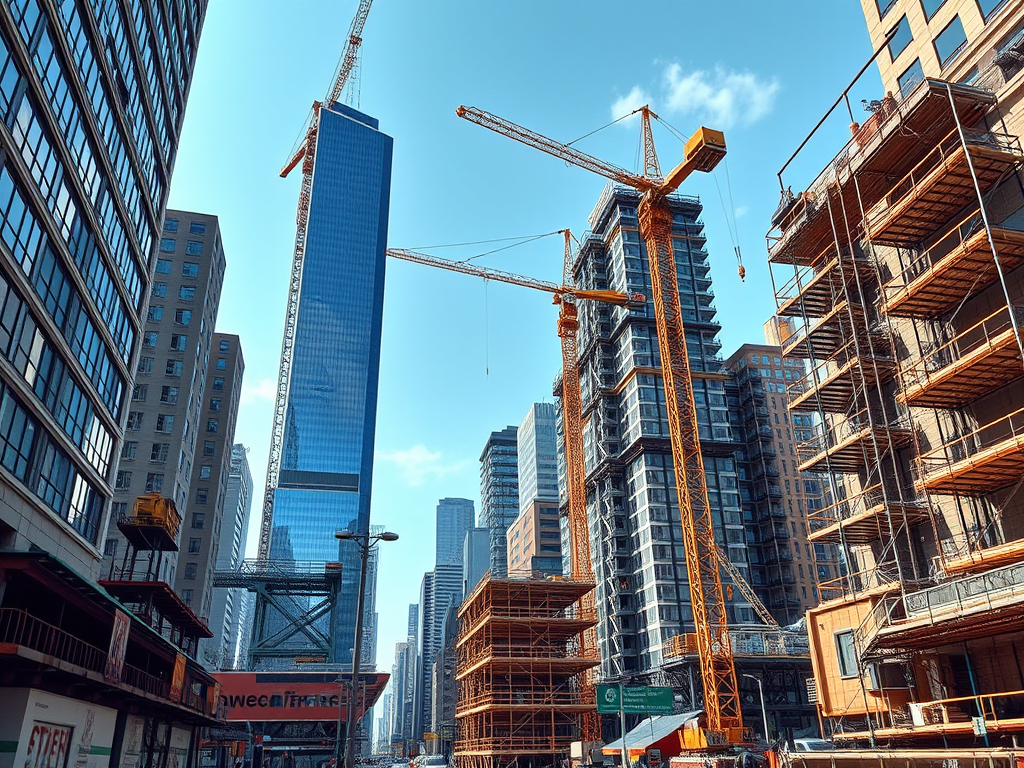
How to Get the Most Out of Your Construction Consultant?
When you’re investing in a construction project—whether it’s a custom estate, a private retreat, or a high-end commercial space—you want to ensure that every detail is managed flawlessly. Hiring a construction consultant is a strategic move that allows you to protect your investment, minimize risk, and achieve a seamless experience from concept to completion. However, simply hiring a consultant isn’t enough; the key is knowing how to leverage their expertise to get the best results.
Here’s how to maximize the value of your construction consultant and ensure your project runs smoothly, efficiently, and to your highest standards.
1. Define Your Vision and Expectations Early
Your consultant is there to bring your vision to life, but they can only do so if they fully understand your goals. Before the project kicks off, clearly communicate your expectations, must-haves, and any concerns you may have. Providing a comprehensive briefing on your lifestyle, aesthetic preferences, functionality requirements, and long-term plans will help them make informed decisions on your behalf.
2. Trust Their Expertise
You’ve hired a consultant because of their deep industry knowledge, connections, and ability to navigate complex projects. While it’s natural to have strong opinions about your investment, allowing your consultant to take the lead in technical matters, risk management, and contractor negotiations will save you time, money, and stress. Think of them as your advocate in the field—someone dedicated to your best interests.
3. Stay Engaged Without Micromanaging
A great construction consultant acts as your eyes and ears on-site, ensuring everything is executed to perfection. While it’s important to stay informed and engaged, try to resist the urge to micromanage. Set up regular check-ins, review progress reports, and ask for key milestone updates, but allow your consultant the space to do what they do best: keeping your project on track, on budget, and up to your standard.
4. Leverage Their Network
One of the biggest advantages of working with a top-tier construction consultant is access to their trusted network of architects, designers, contractors, and vendors. Rather than relying on generic recommendations, tap into their industry connections to ensure you’re working with the best professionals who align with your vision and expectations. This will lead to a higher-quality outcome and a smoother process.
5. Prioritize Transparency and Open Communication
Construction projects involve many moving parts, and unexpected challenges can arise. Establishing a transparent, open line of communication with your consultant will ensure that issues are addressed proactively and solutions are implemented efficiently. Whether it’s a design change, a timeline adjustment, or a budgeting concern, staying in sync with your consultant will prevent surprises and keep the project moving forward seamlessly.
6. Understand the Value They Bring Beyond Construction
A construction consultant does more than just oversee the build. They play a critical role in budget management, quality control, risk mitigation, and ensuring that your project aligns with your personal or brand image. Their ability to foresee potential roadblocks, negotiate favorable terms, and optimize decision-making saves you from costly mistakes and delays.
7. Give Feedback and Celebrate Milestones
Your consultant is committed to delivering excellence, and your feedback is valuable in ensuring they meet your expectations. Be clear about what’s working well and where adjustments may be needed. At the same time, recognizing milestones and achievements throughout the process helps maintain momentum and a positive working relationship.
Elevate Your Project with the Right Construction Consultant
By taking a strategic approach to working with your construction consultant, you can turn a complex project into a seamless, stress-free experience. With the right partnership, you can enjoy the journey of bringing your vision to life—confident that every detail is expertly managed and your investment is protected.
Are you ready to embark on a new construction project? Let’s discuss how a tailored consulting approach can make all the difference. Reach out today to start the conversation.

How Construction Management Saves Time and Money for High-Profile Property Owners
For A-list celebrities, musicians, professional athletes, influencers, and family offices, real estate projects aren’t just about building a home or a commercial space—they’re about creating a secure, luxurious, and highly personalized environment. Whether it’s a state-of-the-art recording studio, a private estate, or an investment property, managing a construction project can quickly become overwhelming.
Without the right expertise, even the most well-funded projects can spiral into delays, unexpected costs, and logistical nightmares. That’s where professional construction management (CM) becomes essential. A seasoned construction manager acts as your advocate, ensuring that every aspect of your project runs smoothly, stays on budget, and delivers top-tier quality—without requiring you to micromanage the details.
Here’s how construction management protects your time, your money, and your peace of mind:
1. Turning Vision into Reality—Without the Hassle
You have a vision—perhaps a custom-built mansion in Beverly Hills, a high-tech penthouse in Miami, or a secluded luxury retreat in Aspen. A CM ensures that your ideas are executed flawlessly, overseeing every phase from design to final walkthrough, so you can focus on your career and lifestyle rather than construction logistics.
2. VIP-Level Project Oversight
High-profile individuals require a level of discretion, security, and precision that standard construction projects don’t always accommodate. A construction manager acts as a trusted point of contact, managing contractors, architects, and designers while maintaining strict confidentiality and ensuring that your project aligns with your personal standards.
3. Budget Control Without Cutting Corners
Even for those with substantial resources, cost overruns are a frustrating reality in construction. A CM negotiates the best pricing with top-tier vendors, ensuring you get the highest quality materials and craftsmanship without unnecessary markups. By tracking every dollar spent, they prevent financial waste and ensure transparency.
4. Eliminating Costly Delays
Time is a valuable asset, and lengthy construction delays can interfere with business schedules, family plans, or investment timelines. A CM proactively anticipates and resolves issues—whether it’s securing permits, managing supply chain disruptions, or coordinating crews—keeping your project on schedule and avoiding unnecessary downtime.
5. Managing Complex Custom Features
For high-end residential and commercial projects, standard construction approaches won’t cut it. Whether you want a private underground garage for your car collection, a soundproof home studio, a wellness spa, or smart-home automation integrated with cutting-edge AI, a CM ensures that your vision is executed seamlessly, with the best specialists in the industry.
6. Security and Privacy Protection
For celebrities and elite clients, security is paramount. A CM carefully vets all contractors and vendors, ensuring that only trusted professionals have access to your property. Additionally, they implement confidentiality agreements and take measures to prevent leaks or disruptions from unwanted attention.
7. Ensuring Investment-Grade Quality
Whether you’re building a personal estate or an investment property, quality matters. A CM enforces the highest construction standards, preventing costly mistakes that could impact resale value or long-term durability. They ensure that every finish, fixture, and design element meets the level of excellence expected in luxury real estate.
Why Construction Management is a Smart Investment
For high-profile clients, construction management isn’t just about building a property—it’s about ensuring a seamless experience with the least amount of stress. By hiring a trusted CM, you gain peace of mind knowing that your project is in expert hands, completed efficiently, and tailored to your exact specifications.
If you’re planning a construction or renovation project and want to ensure it’s executed with precision, discretion, and financial efficiency, partnering with a professional construction manager is the key to success. Your time is too valuable to be spent chasing contractors—let an expert handle it while you enjoy the results.
Peter Videv is a seasoned construction project manager and real estate consultant with a diverse, multicultural background. He has significant experience in high-end luxury projects across hospitality, residential, and retail sectors both nationally and internationally.
Your vision. Our Expertise
8 Key Milestones Every Construction Project Should Track
Managing a construction project is like conducting a symphony—every part needs to come together at the right time. By tracking crucial milestones, you ensure harmony, avoid surprises, and keep the project on course. Let’s explore the eight milestones every construction project manager and owner representative should prioritize:
1. Project Initiation and Planning – Laying the Groundwork
The blueprint for success starts here. During this phase, stakeholders align on the project’s scope, budget, and schedule. Securing construction permits, finalizing contracts, and conducting feasibility studies are essential. Solid planning now means fewer headaches later.
2. Design and Pre-Construction – Turning Vision into Plans
Here, ideas take shape. The design phase includes architectural drawings, value engineering reviews, and contractor selection. Critical approvals and permits ensure everything is ready for a seamless construction start.
3. Groundbreaking – The First Shovel, The First Step
Groundbreaking is more than symbolic—it marks the start of on-site work. This is the time to manage resources, monitor progress, and tackle issues as they arise.
4. Topping-Off Ceremony – Reaching New Heights
The structure stands tall! Topping-off celebrates the completion of the building’s framework, a major construction achievement. It’s also a checkpoint to assess structural integrity and prepare for interior work.
5. Building Enclosure – Securing the Site
Once exterior walls, windows, and the roof are in place, the building is protected from the elements. This milestone allows interior work to continue without interruption.
6. Utilities Connections – Powering Up Progress
Electricity, water, gas, and telecommunications connect the building to the outside world. Timely utility hookups are crucial to ensure smooth system tests and interior fit-outs.
7. Substantial Completion – Almost There!
At this stage, the building is ready for final inspections and may receive a Temporary Certificate of Occupancy (TCO). Walk-throughs help identify and resolve punch list items before the official handover.
8. Project Closeout and Handover – The Grand Finale
The final step is delivering the finished project. This includes obtaining the full Certificate of Occupancy, completing final inspections, and providing essential documentation such as warranties and as-built drawings.
Conclusion
Milestones are more than checkpoints—they’re celebrations of progress and opportunities to stay on track. As a seasoned Construction Project Manager and Owner Representative, I help clients navigate these critical stages with confidence. For more insights, follow my blog or connect with me on LinkedIn.

Common Construction Mistakes Owners Can Avoid with the Right Representation
Alright, listen up. You know what’s worse than a construction project going over budget? A construction project going over budget while ALSO being late, full of nonsense, and making you question all your life choices. You ever had a contractor tell you, “Yeah, we should be done in six months”—and two years later, you’re standing in a half-finished building, looking like you just came out of a bad relationship?
That’s what happens when you don’t have the right representation.
Ladies and gentlemen, let me introduce you to The Right Representation. It ain’t an app. It ain’t some hipster start-up promising AI-powered construction miracles. It’s a real, experienced human being in your corner, making sure your project doesn’t turn into a never-ending circus. Think of it like having a lawyer, a referee, and a drill sergeant rolled into one—someone who makes sure your money goes where it should, your timeline doesn’t turn into a fantasy novel, and contractors don’t vanish like your cousin who still owes you fifty bucks.
Let’s break it down:
1. The Budget Mirage
You THINK your project costs $1 million. That’s cute. By the time the dust settles, you’re looking at $1.5 million—and you still don’t have working plumbing. What happened? I’ll tell you what happened. Contractors pulled a Houdini with your money, change orders popped up like spam emails, and suddenly, “We didn’t see that coming” becomes the official project slogan. A real owner’s rep makes sure your budget is an actual number, not a rough suggestion.
2. The Schedule Illusion
“We’ll be done in six months!” Oh, will you? That’s what they all say. Fast forward a year later, and you’re standing there like, “Where is everybody?” Look, construction schedules are like Tinder profiles—everybody looks great on paper, but in reality? Let’s just say expectations rarely meet reality. A real owner’s rep makes sure folks stay on track, no ghosting, no excuses.
3. The “What Did I Just Approve?” Syndrome
Blueprints are like Ikea instructions—if you don’t understand them, you might end up with a staircase that leads to nowhere. Without someone who knows what’s up, you might approve a layout that puts the bathroom next to the reception desk. And nothing says “bad decision” like hearing flushing sounds while signing a million-dollar deal. A good rep saves you from approving something that future-you will deeply regret.
4. The Contractor Shuffle
Ever seen a contractor disappear into thin air? It’s like a magic trick—but instead of applause, you get an unfinished building and a headache. Without oversight, some contractors get real creative with disappearing acts, excuses, and—let’s be honest—straight-up nonsense. A good rep keeps them in check, makes sure they show up, do their job, and don’t pull some “Sorry, I got another job elsewhere” nonsense while you’re left holding the bag.
5. The Quality “Oops”
That “high-end flooring” you paid extra for? Turns out it scratches easier than your grandma’s old records. And those “custom cabinets”? More like cardboard with a fancy finish. If you don’t have someone checking materials and work quality, you’ll end up paying top dollar for bottom-shelf results. A solid owner’s rep makes sure what you paid for is actually what you get—because nobody wants to find out their “granite countertops” are actually painted plywood.
The Bottom Line
Building something is exciting. It’s big, it’s bold, it’s your dream coming to life. But without the right representation? It’s also a disaster waiting to happen. You wouldn’t skydive without a parachute, so why would you take on a multi-million dollar construction project without a pro in your corner? Get the right expert, avoid the traps, and keep your sanity intact.
PS: If you hire amateurs, you’re gonna end up hiring professionals to clean up their mess. Save yourself the trouble—hire the right professionals from day one.
Common Construction Mistakes Owners Can Avoid with the Right Representation
Common Construction Mistakes Owners Can Avoid with the Right Representation
Alright, listen up. You know what’s worse than a construction project going over budget? A construction project going over budget while ALSO being late, full of nonsense, and making you question all your life choices. You ever had a contractor tell you, “Yeah, we should be done in six months”—and two years later, you’re standing in a half-finished building, looking like you just came out of a bad relationship?
That’s what happens when you don’t have the right representation.
Ladies and gentlemen, let me introduce you to The Right Representation. It ain’t an app. It ain’t some hipster start-up promising AI-powered construction miracles. It’s a real, experienced human being in your corner, making sure your project doesn’t turn into a never-ending circus. Think of it like having a lawyer, a referee, and a drill sergeant rolled into one—someone who makes sure your money goes where it should, your timeline doesn’t turn into a fantasy novel, and contractors don’t vanish like your cousin who still owes you fifty bucks.
Let’s break it down:
1. The Budget Mirage
You THINK your project costs $1 million. That’s cute. By the time the dust settles, you’re looking at $1.5 million—and you still don’t have working plumbing. What happened? I’ll tell you what happened. Contractors pulled a Houdini with your money, change orders popped up like spam emails, and suddenly, “We didn’t see that coming” becomes the official project slogan. A real owner’s rep makes sure your budget is an actual number, not a rough suggestion.
2. The Schedule Illusion
“We’ll be done in six months!” Oh, will you? That’s what they all say. Fast forward a year later, and you’re standing there like, “Where is everybody?” Look, construction schedules are like Tinder profiles—everybody looks great on paper, but in reality? Let’s just say expectations rarely meet reality. A real owner’s rep makes sure folks stay on track, no ghosting, no excuses.
3. The “What Did I Just Approve?” Syndrome
Blueprints are like Ikea instructions—if you don’t understand them, you might end up with a staircase that leads to nowhere. Without someone who knows what’s up, you might approve a layout that puts the bathroom next to the reception desk. And nothing says “bad decision” like hearing flushing sounds while signing a million-dollar deal. A good rep saves you from approving something that future-you will deeply regret.
4. The Contractor Shuffle
Ever seen a contractor disappear into thin air? It’s like a magic trick—but instead of applause, you get an unfinished building and a headache. Without oversight, some contractors get real creative with disappearing acts, excuses, and—let’s be honest—straight-up nonsense. A good rep keeps them in check, makes sure they show up, do their job, and don’t pull some “Sorry, I got another job elsewhere” nonsense while you’re left holding the bag.
5. The Quality “Oops”
That “high-end flooring” you paid extra for? Turns out it scratches easier than your grandma’s old records. And those “custom cabinets”? More like cardboard with a fancy finish. If you don’t have someone checking materials and work quality, you’ll end up paying top dollar for bottom-shelf results. A solid owner’s rep makes sure what you paid for is actually what you get—because nobody wants to find out their “granite countertops” are actually painted plywood.
The Bottom Line
Building something is exciting. It’s big, it’s bold, it’s your dream coming to life. But without the right representation? It’s also a disaster waiting to happen. You wouldn’t skydive without a parachute, so why would you take on a multi-million dollar construction project without a pro in your corner? Get the right expert, avoid the traps, and keep your sanity intact.
PS: If you hire amateurs, you’re gonna end up hiring professionals to clean up their mess. Save yourself the trouble—hire the right professionals from day one.

The Role of an Owner Representative in Construction Projects
When people think of construction projects, they often picture cranes, busy job sites, and the hum of heavy machinery. But behind every successful project is someone quietly pulling the strings to keep everything running smoothly: the Owner Representative (OR). Think of them as the project’s unsung hero, making sure deadlines are met, budgets aren’t blown, and chaos stays at bay.
Who Is an Owner Representative?
Picture this: you’re planning to build your dream office. You have a vision, but juggling architects, contractors, permits, and a mountain of paperwork? Not exactly your idea of fun. That’s where an OR steps in. They act on your behalf, turning your vision into reality while you focus on, well, anything else.
In large-scale projects, like skyscrapers or sprawling campuses, the OR becomes the glue holding everyone together—owners, architects, contractors, and stakeholders—making sure the project stays on track, on budget, and up to spec.
What Does an Owner Representative Actually Do?
- Project Oversight: Think of the OR as the project’s GPS. They monitor progress, making sure every milestone is hit without detours or dead ends.
- Budget Management: They keep an eagle eye on spending, spotting cost-saving opportunities and steering clear of budget black holes.
- Communication Hub: Bridging the gap between technical jargon and plain language, the OR ensures everyone is on the same page.
- Risk Management: They’re like project fortune-tellers, identifying potential risks early and crafting strategies to dodge disasters.
- Quality Assurance: From reviewing designs to inspecting sites, the OR makes sure the final product isn’t just done—it’s done right.
Why You Need an Owner Representative
- Objective Advocate: Unlike contractors or designers with their own agendas, the OR is your dedicated ally, focused solely on your goals.
- Stress Reliever: With an OR handling the nitty-gritty, you can breathe easy knowing someone’s got your back.
- Efficiency Expert: Projects with an OR often finish faster and cost less, thanks to proactive management and problem-solving.
The Bottom Line
Whether you’re a seasoned developer or diving into your first project, having an Owner Representative is like having a trusted co-pilot. They help you navigate the complexities, avoid turbulence, and land your project safely and successfully.

The Importance of Pre-Construction Planning for a Successful Project: An Honest Take (at least we tried…)
Let’s be real: when most people hear the term “pre-construction planning,” their eyes glaze over faster than a freshly poured concrete slab. It sounds like one of those things you know is important—like flossing or reading the terms and conditions—but secretly hope you can skip. Spoiler alert: you can’t. Because skipping pre-construction planning is like trying to bake a cake without a recipe and hoping it’ll taste like Michelin-starred dessert. (Spoiler alert #2: it won’t.)
Clients are also anxious about seeing things happening onsite. So many times I get the concerned question: “When are you starting?” We refocus the discussion on “Are we ready to start?” and “Does the completion date work for you?”
So, buckle up as we take an honest dive into why pre-construction planning is the unsung hero of any successful project—and how ignoring it might leave you with more chaos than a toddler with a hammer.
Step One: Dream Big, but Don’t Skip the Blueprint
Picture this: you’ve decided to build the house of your dreams. It’ll have an infinity pool, a marble staircase, and a walk-in closet big enough to host a yoga class. Great! Except, oops, you forgot to plan for, say, walls. Or plumbing. Or literally any of the boring-but-essential stuff that makes a house, well, livable.
This is what happens when you skip pre-construction planning. You’re left with big dreams and even bigger regrets when your infinity pool is filled with rainwater because you forgot to include a cover.
Words of wisdom: pool design is a very specific skill and designing it properly will leave you with an enjoyable product, rather than one that gives you headaches every day. Hire the right professional from day one.
Budget: The Fantasy vs. Reality Show
“We’ll just wing it,” they said. “How hard can it be?” they wondered. And that, dear reader, is how budgets are obliterated faster than your patience at the DMV.
Pre-construction planning is where you decide if your project’s budget belongs in the “realistic” category or the “you’ll be selling a kidney” category. It’s the difference between knowing you can afford a solid oak front door or realizing too late that you’re stuck with something that looks suspiciously like cardboard painted brown.
Numerous times, more than I would admit, we had to deal with the “Champagne expectations on a beer budget…”
We have the means to resolve the disconnect and reconcile both parts of the equation through design, procurement, performance buys and careful value engineering.
Schedules: Who Needs Sleep Anyway?
Ah, the project schedule. A magical document where deadlines go to die if you don’t plan properly. Without pre-construction planning, your timeline will resemble one of those “choose-your-own-adventure” books: thrilling, unpredictable, and guaranteed to lead to disaster at least 90% of the time.
Want your project finished on time? (Of course you do—you’re not a masochist.) Then you’d better map out every detail, from material deliveries to contractor schedules. Otherwise, don’t be surprised when your “quick reno” turns into a three-year odyssey that makes “The Lord of the Rings” look like a weekend trip.
We work with all our clients to give them the required level of information from a General Schedule to weekly updates, all the way to a Detailed Schedule if that is what they want to see. We help you not loosing sight of the big picture while we sort out the details for you.
The “Who’s in Charge Here?” Game
Pre-construction planning is also where you decide who’s steering the ship. Without it, your project will quickly devolve into a construction version of “Lord of the Flies,” with everyone arguing over whose turn it is to bring the donuts, let alone manage the actual building.
Assigning roles, responsibilities, and accountability during pre-construction planning ensures that everyone—from the architect to the guy who’s really enthusiastic about jackhammers—knows their job. Otherwise, expect finger-pointing, chaos, and at least one person saying, “I thought you were handling that?”
We organize projects big and small, and we will discuss with you early on what type of assistance and project structure will best meet your needs. Do you need an All Star team or can you live with the bare minimum?
The “Unforeseen Issues” Drinking Game
Surprise! That’s the unofficial motto of every construction project ever. Except, with good pre-construction planning, you can at least reduce the number of “surprises” to a manageable level.
Skipped the soil testing? Surprise: your building is sinking. Didn’t check local zoning laws? Surprise: your dream pool is now a koi pond. Neglected to factor in seasonal weather patterns? Surprise: your timeline just got extended by three months because apparently, concrete doesn’t pour itself in a blizzard.
We will help you mitigate your exposure and deploy your budget efficiently, avoiding the dreaded “I have another Change Order to review with you.”
In Conclusion: Plan Like Your Sanity Depends on It
Pre-construction planning might not be glamorous, but it’s the glue that holds your project together. Without it, you’re setting yourself up for budget blowouts, timeline tantrums, and enough stress to turn your hair gray faster than you can say “change order.”
So, embrace the spreadsheets. Love the logistics. Cherish the checklists. Because when your project wraps up on time and under budget, you’ll thank your pre-construction planner—and maybe even buy them a drink. Just make sure it’s not during the “unforeseen issues” drinking game, or you’ll both need a ride home.

Understanding Frost Lines in Construction and Their Importance
Introduction
In construction, understanding and accounting for frost lines is critical for ensuring the longevity and functionality of structures. Frost lines, also known as frost depths, refer to the maximum depth in the ground where soil water freezes during the coldest months. This depth varies based on geographical location, soil type, and climate. Properly addressing frost lines is essential to prevent damage to water supply systems, foundations, and other subsurface structures.

The Concept of Frost Lines
The frost line is determined by local weather conditions, and in colder climates, it can extend several feet below the surface. For example, in northern regions, frost depths can exceed four feet, while in milder climates, they may be as shallow as a few inches.
When water in the soil freezes, it expands, exerting upward pressure on structures—a phenomenon known as frost heave. This can lead to significant structural damage if not properly mitigated during the design and construction process.
Importance of Frost Lines in Water Lines and Supply Systems
Water lines must be buried below the frost line to prevent freezing, which can lead to pipe bursts, service interruptions, and costly repairs. Installing pipes below this depth ensures that they remain unaffected by freezing soil temperatures, maintaining consistent water flow throughout the year.
Key considerations include:
- Local Frost Depths: Designers must use regional frost depth maps to determine the minimum burial depth for pipes.
- Insulation: In areas where pipes cannot be placed below the frost line, insulation and heating mechanisms may be employed as alternatives.
- Slope and Drainage: Proper grading around water lines prevents water accumulation that could exacerbate freezing risks.
Frost Lines and Concrete Foundations
Concrete foundations are also vulnerable to frost heave if not installed properly. Frost heave can cause uneven lifting, cracking, and structural instability in buildings. To mitigate these risks:
- Frost-Protected Shallow Foundations: This technique uses insulation to create a thermal barrier, reducing the risk of freezing soil around the foundation.
- Depth of Footings: Traditional footings are placed below the frost line to avoid the effects of soil freezing and expansion.
- Drainage Systems: Effective drainage around the foundation minimizes water saturation in the soil, which reduces the risk of frost-related issues.
Conclusion
Frost lines are a critical consideration in the construction of water supply systems and concrete foundations. Proper design and installation that account for frost depths ensure the safety, functionality, and durability of structures. Neglecting frost lines can result in costly repairs, service interruptions, and structural failures. By understanding regional frost depths and employing appropriate construction techniques, builders can safeguard against these risks and achieve long-lasting results.
This blog post underscores the importance of frost lines in construction and highlights practical measures to address associated challenges, ensuring both compliance with building codes and the longevity of critical infrastructure.

How to Stay Ahead of Schedule Every Time (Without Losing Your Mind)

Construction Scheduling: A Love-Hate Relationship?
Let’s face it—construction schedules and reality often feel like oil and water. A few years ago, during a meeting, a client’s associate hit me with this gem:
“Construction schedules are useless. We’re always behind!”
My reply?
“That’s like saying washing your hands is useless because they just get dirty again. You still do it, right?”
Schedules are the same way. They’re not some unchangeable holy grail (except the delivery date, of course). They’re more like a map: you don’t throw it away when there’s traffic; you reroute and keep going.
The General Schedule: The Blueprint of Sanity
First things first: we start broad. I sit down with the client, understand their goals, deadlines, and time constraints, and craft what I call a “General Schedule.” Think of this as the skeleton of the project: deadlines, key tasks, and milestones.
Some tasks are non-negotiable—you can’t fast-track permits, hazardous material removal, or bureaucratic red tape. Others depend on consultants, contractors, and available resources (a.k.a. the holy trinity of manpower, money, and miracles).
The General Schedule sets global goals. It’s like saying, “We’re road-tripping to Vegas. We’ll stop for gas in Denver and tacos in Albuquerque, but the exact playlist? TBD.”
Detailed Scheduling: When Things Get Serious
Here’s where the rubber meets the road. Detailed schedules need input from everyone—architects, engineers, contractors, and consultants. This step is where I dig deep, figure out approval processes, work habits, and how fast contractors can move without setting off a chain reaction of chaos.
And remember: some things can’t be rushed. For example, it takes nine months to make a baby. Nine women working together won’t deliver a baby in a month. (Construction is weirdly like that.)
Creating a detailed schedule without involving the actual players is like trying to run a dictatorship. Sure, you can do it, but no one’s going to enjoy it—or stick to it. Collaboration is the secret sauce.
For clarity’s sake, I like to split the schedule into two parts:
- Design Schedule: The architects and engineers’ playground.
- Work Schedule: The contractors’ battlefield.
Tracking Progress: Because Schedules Don’t Run Themselves
Once the detailed schedule gets everyone’s seal of approval, it’s my job to play referee. I track progress, report transparently, wave the red flag if delays pop up, and suggest how to get things back on track.
Sometimes that means reallocating resources, reshuffling timelines, or just figuring out why someone ordered 500 pink bricks instead of red. (True story.)
Washing Hands and Staying Flexible
Remember that handwashing metaphor? Here’s where it really shines. A good schedule is like a hand sanitizer dispenser—constantly refreshed and adjusted to keep the project healthy.
Flexibility is everything. If one task hits a snag and starts holding up others, the schedule needs to be updated ASAP. Regular updates keep problems manageable and avoid those late-stage BOOM moments that everyone dreads.
But let’s be real: a schedule is only as good as the team, resources, and finances behind it. If a contractor’s dragging their feet or funding’s delayed, no amount of scheduling wizardry can fix that. What it can do is document the chaos, serve as a collective memory, and help assign responsibility when disputes arise.
The Secret to Always Staying Ahead
Flexibility and frequent updates are your best friends. When a schedule reflects reality—not just the fantasy you started with—it becomes a powerful tool. Address problems early, adapt like a pro, and avoid time bombs. That’s how you stay ahead of schedule without losing your hair.
Now, go wash your hands—and your schedule!

The Benefits of Hiring an Owner’s Representative for Your Construction Project

Embarking on a construction project can be both exciting and overwhelming. From budgeting and scheduling to managing contractors and ensuring quality control, the sheer volume of responsibilities can strain even the most organized project owners. This is where hiring an owner’s representative (OR) becomes invaluable. Here are some key advantages of bringing an OR on board:
1. Expert Guidance from Start to Finish
An owner’s representative serves as your trusted advisor, equipped with expertise in construction management, design processes, and project delivery methods. They act as a bridge between you and all project stakeholders—architects, engineers, contractors, and vendors—ensuring the project aligns with your vision and goals.
2. Cost and Time Savings
With experience in managing budgets, contracts, and schedules, an OR ensures that every dollar is spent wisely and that the project progresses efficiently. They mitigate risks by identifying potential issues early and implementing solutions, preventing costly delays and overruns.
3. Objective Decision-Making
The OR works solely in your best interest, providing unbiased recommendations and keeping the focus on your priorities. Unlike contractors or architects, who may have their own agendas, the OR ensures that all decisions are aligned with your needs and expectations.
4. Improved Communication and Coordination
Construction projects often involve multiple parties, each with specific responsibilities. An OR streamlines communication among all stakeholders, reducing misunderstandings and ensuring everyone remains on the same page. This coordination is critical to maintaining project momentum and quality.
5. Quality Assurance
An experienced OR monitors the construction process closely, ensuring that all work adheres to agreed-upon plans, specifications, and industry standards. They conduct regular site visits, review reports, and address any discrepancies promptly, safeguarding the quality of the final product.
6. Risk Management
Construction projects inherently involve risks—whether related to design flaws, unforeseen site conditions, or contractual disputes. An OR proactively identifies and mitigates these risks, protecting your investment and reducing the likelihood of litigation or costly corrective measures.
7. Focus on Your Core Responsibilities
By delegating the complexities of project management to an OR, you can focus on your primary business or personal responsibilities without being consumed by the details of construction. This ensures peace of mind while your project is managed by a dedicated professional.
Conclusion
Hiring an owner’s representative is a strategic investment that can significantly enhance the success of your construction project. By providing expert oversight, reducing risks, and ensuring your interests are prioritized, an OR allows you to enjoy the benefits of a well-executed project without the stress of managing it alone. If you’re planning a construction project, consider bringing an OR on board to make the process smoother, more efficient, and ultimately more rewarding.
Would you like to explore how an owner’s representative can benefit your specific project? Let’s discuss!

Quick Snap: Luxury Residential Real Estate in NYC
How is the luxury residential real estate market in NYC?If you wonder, you can always have a quick look at Streeteasy.com.
Or read this interesting Blog post on Empire State Living’s website.
And particularly have a look at what is for sale in the 30 M$ + range.
I do it every week and find it particularly informative.
As of now there are 79 listings siting on the top of the market.
More details are available here.
This is way north of a 3 B$ valuation.
After crunching some numbers, this is what I ended up with.
- Total $ amount on the market: $3,280,345,000
- Average sales price: $46,862,071
- Average price per sf: $6,418.74
Average sales price is north of 46 M$!
Now, all will not sell for the asking price, but this number sounds always pretty interesting.
Let’s check in again next week with more market updates.
